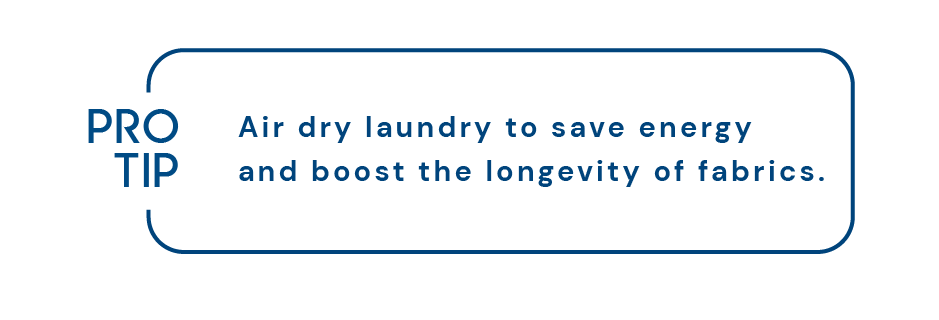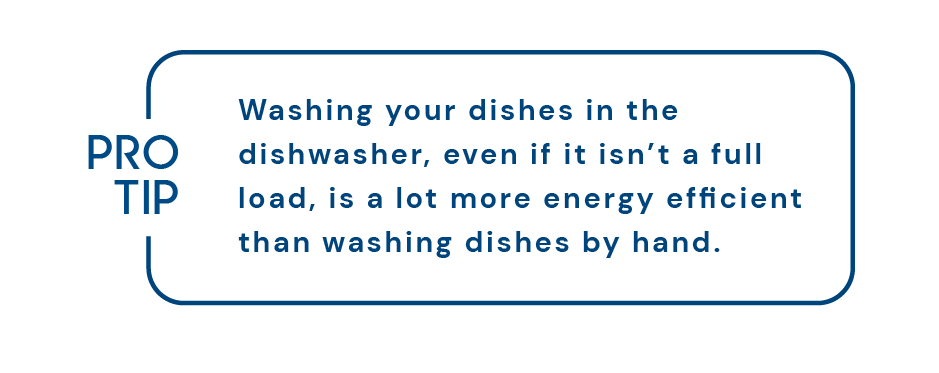Renters, don’t miss these no-cost tips for a lower electricity bill.

Renters, this one’s for you! Saving energy at home isn’t just for homeowners. There are lots of simple, easy and totally free things you can do to lower your household utility costs. Because, let’s face it, unless something breaks, it’s pretty unlikely your landlord will proactively invest in costly energy-saving upgrades or repairs, like ENERGY STAR appliances or a new energy efficient HVAC system. Let’s take a look at a home’s biggest electricity users and some no-cost energy-saving hacks that can put a little extra green back in your pocket.
Heating and cooling
Heating and cooling your home accounts for about 32% of your total electricity use.1 These small actions can make a big difference, though.
Keep air vents open and unobstructed.
Your HVAC system is built to provide the proper amount of heating and cooling for a home your size. So, when you close air vents and registers, your system will still produce and distribute the same amount of heat or cool air, but only now with fewer places for that air to go. That increased pressure puts a real strain on your duct work, and it forces your HVAC system to work harder. If you have floor vents, make sure nothing obstructs their air flow, like furniture, rugs or curtains.
Set your thermostat to 68° F to 70° F during the day in the winter.
The Department of Energy estimates you can save up to 10% on your annual heating expenses when you cut the heat back 7-10 degrees for eight or more hours at a stretch — perfect for a day in the office or when you’re out of town. When you’re home, aim for around 68° F to 70° F. For every one degree you lower your thermostat, you can save around 3% more energy.
Pro tip: Returning home after a day at work or a trip? Your impulse might be to set your thermostat way beyond your desired temperature to heat your home quicker. But resist the urge to surge! This does not increase the speed at which your home will warm up, but it will put extra stress on your system and use more energy.
Avoid using emergency heat unless it’s a true emergency.
Emergency heat is only for emergencies! It is not for daily use. The only time you should use emergency heat is if your primary heat pump and auxiliary heat (the heat that automatically turns on if the heat pump malfunctions) go out. Emergency heat, which has to be manually turned on and off, costs significantly more than your everyday heat and will drive up your energy bill.

Water heating
Heating water, like for showers and the dishwasher, makes up 11% of your home’s total electricity use, so anywhere you can scale back in this area is going to make a nice impact on your bill.1
Wash clothes in cold water on the high spin cycle.
Your clothes get just as clean using cold water, so give this tip a whirl. When you wash clothing in hot water, you’ll use more electricity as your water heater works to, well, heat your water! Hot water is also harsh on clothes, which can mean having to replace clothing more often. Set your washing machine to a high spin cycle. This will ensure as much water as possible is spun out of your clothing and they’ll dry faster in the dryer.
Lower your water heater temperature to 120° F.
Most households have the temperature of their electric water heater set too high. By lowering your water heater temperature to 120° F, not only will you save money on your electricity bill (because you need electricity to make hot water) but you can also avoid burning yourself with water that is too hot.
Take shorter showers.
OK, yes, for long shower lovers this might seem impossible. But if you can reduce your shower time to 5-10 minutes, it reduces the amount of energy required to heat enough hot water for a 20-minute dip. Lower your electricity bill and avoid pruney skin — a win-win!
Household appliances: washing machine, dryer, stove & dishwasher
The way you use many household appliances, including your washing machine, dryer, stove and dishwasher, can drive up your electricity bill. These appliances account for 7% of your home’s energy use, and that’s not including the refrigerator or freezer, which we’ll get to in the next section.1
Don’t overstuff the washing machine or dryer.
Unless you’re one of those rare people who loves to do laundry, then you’re probably trying to knock out this chore as quickly as possible. But, if you’re overstuffing your washing machine and dryer, you’re creating more work for yourself — work that will ultimately lead to greater energy use.
Clothes need room to move around in the washing machine so that detergent can actually reach everything and your items can go through rinse cycles without trapping dirty water. The same logic applies to your dryer: If a dryer is packed full, there’s no room for warm air to move around and through your clothing. This leads to additional drying cycles, which will not only drive your electricity bill up but will also do a number on your clothing.

Match pot and pan sizes to burner sizes.
If you’re using a small saucepan, use your smaller burners. Large burners use more energy, and if there’s nothing there to heat, then you’re burning up easy savings.
Skip the dry cycle on your dishwasher.
Instead of using your dishwasher’s drying feature, opt to let your dishes air dry. Because, let’s be honest, even with the dry cycle, some of your dishes still come out wet! Once your dishwasher is done, crack the door and let evaporation work its magic.

Refrigerator & freezer
Just this one appliance makes up 7% of your total household electricity use.1 Keep your food fresh and safe and your electricity bill low with these fridge and freezer energy conservation tips.
Reset your refrigerator temperature to 35-38° F.
Got 60 seconds? Because that’s about all you’ll need to make this free and effective change. Open your refrigerator, look for the temperature gauge and then adjust the temperature to anywhere between 35° F and 38° F. This is the most energy efficient temperature to set your fridge while keeping your food safe. When you’re done with that, head over to the freezer and set its temperature to 0-5° F.
Keep your fridge full.
High food costs can get in the way of practicing this tip, but when possible, keep your fridge full. Not overstuffed or bursting at the seams, but comfortably full, even if that’s adding a couple of gallon jugs of water. Refrigerated items need enough space for cool air to move around them, but once all your food and drinks are cold, everything works together to maintain the right temperature without too much additional energy from the appliance itself.
Lighting, TVs & computers
Between lighting, TVs, gaming systems, laptops and all the other devices in our homes, it can all add up to a decent chunk of your electricity bill, about 10%, in fact.1 Fortunately, lowering energy use in this area is as simple as the flip of a switch.
Turn off the lights when you leave the room.
It really is one of the easiest behavioral changes to practice. When you leave a room, flip that light switch on your way out even if you’ll return in a few minutes. Small habit changes like this also reinforce an energy-saving mindset. Soon you’ll be looking for ways to boost your energy efficiency everywhere!
Turn off and unplug devices.
A common energy myth is that if it’s turned off, it’s not using power. But we’re here to bust that myth! Yes, turning off your TV saves more energy than keeping it on all night after you fall asleep. But it’s still using power even when it’s off. We call that kind of energy “vampire energy,” because as long as something is plugged in, it’s sucking energy and increasing your energy bill. You’ll save more energy when you power down electronics and other devices and unplug them from their outlets. Or, if you have multiple things plugged into a power strip or surge protector, flip the switch when you’re done for the day to cut power to everything.
Want to save more energy and money around your home?
Looking for more ways to save? Check out “25 way how to save on your energy bill” or uncover the ways your home is using (or losing) energy with our free DIY Home Energy Assessment. This self-guided assessment asks you questions about your home, and then provides you with an easy-to-read report with customized energy-saving recommendations. Plus, you’ll receive an exclusive energy-saving kit and a $10 home improvement store gift card in the mail.



